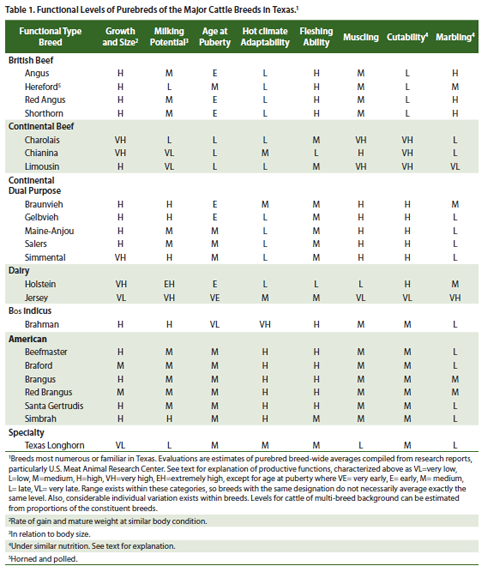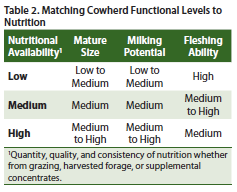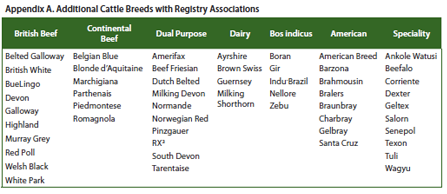In Beef Cattle What Breed Is a Balancer
Stephen P. Hammack
Download the PDF | Email for Questions
Classification and Breeds | Functional Traits | Breeds and Functional Types | Matching Levels | Using Functional Types
The subject of breeds intrigues most beef cattle producers. However, breeds are only part of a genetic strategy that should include:
- Matching applicable performance or functional levels to environmental, management, and marketing conditions
- Choosing a breeding system, either continuous (in which replacement females are produced within the herd) or terminal (in which replacements are introduced externally)
- Selecting genetic types, breeds within types, and individuals within breeds that are compatible with the performance level needed and breeding system chosen.
Genetic Classifications and Breeds
Cattle can be divided into two basic classifications, Bos taurus (non-humped) and Bos indicus (humped, also called Zebu). Cattle are not native to the western hemisphere. The Bos taurus in the United States originated in the British Isles and western continental Europe. The Bos indicus arose in south central Asia.
There are some intermediates containing both Bos taurus and Bos indicus. Some intermediates created in the United States, particularly in Texas, are commonly referred to as American breeds, which will be discussed later.
Although it has no strict definition, a breed can be described as animals of common origin with certain distinguishing characteristics that are passed from parent to offspring. Breed characteristics result from both natural selection and from that imposed by people.
Currently, more than 75 breeds can be registered in the United States. For a discussion of breed development, see another publication in this series, E-180, Texas Adapted Genetic Strategies for Beef Cattle—VI: Creating Breeds and Composites.
Most breeds have registry associations that record ancestry, define and document characteristics, and promote the breed. In this publication, estimates of functional traits or characteristics are based on estimates of breed averages, but individuals can vary considerably within breeds.
Functional Traits or Characteristics
The major functional traits important in Texas beef production include body size, milking potential, age at puberty, hot climate adaptability, fleshing ability, muscle expression, cutability, and marbling.
Body size
Body size is best evaluated as weight at a stated level of condition or body fatness. Although there are exceptions, weight at all ages tends to be positively related—cattle heavier at birth tend to be heavier throughout life. Genetically larger animals usually gain weight faster, and weight and nutritional requirements for body maintenance are closely related.
Size is discussed in Extension publication E-188, Texas Adapted Genetic Strategies for Beef Cattle—III: Body Size and Milking Level. Frame score, an objective measure of skeletal dimension used to estimate current and future body size, is discussed in Extension publication E-192, Texas Adapted Genetic Strategies for Beef Cattle—X: Frame Score and Weight.
An important inconsistency occurs in Bos indicus in body size relationships. Calves from dams containing Bos indicus inheritance are relatively small at birth, usually resulting in few difficulties in calving. However, calves by Bos indicus sires out of Bos taurus dams often are relatively large, so calving may be more difficult.
Milking potential
Milking potential is the genetic capability to produce milk. This is not the actual volume of milk produced, which also is influenced by the cow's nutrition and the calf's growth potential and nursing pressure.
To characterize milking potential accurately, it should be evaluated relative to body size. Higher-milking females need more nutrients for body maintenance and require higher-quality diets, even when not lactating. Again, consult E-188, Texas Adapted Genetic Strategies for Beef Cattle—III: Body Size and Milking Level.
Age at puberty
Age at puberty relates to body size, milking potential, and genetic classification. Smaller cows and higher milking types usually mature earlier, whereas Bos indicus mature relatively late. Although higher milking females, even large ones, often reach puberty and conceive when relatively young, subsequent fertility can suffer because they may become thin after beginning lactation. While Bos indicus types reach puberty relatively late, their productive life is usually longer.
Hot climate/tropical adaptability
Adaptability to hot climates is highest in cattle with Bos indicus inheritance, but some Bos taurus are reasonably heat tolerant. Animals with lighter colored, short hair coats and dark skin are best adapted.
High humidity intensifies the effects of heat, especially because hot, humid climates often add the stresses of parasites and low-quality forage. Heat with humidity stresses cattle that fail to shed long, thick hair coats, particularly darkcolored ones. As might be expected, animals tolerant to hot climates are less adapted to cold.
Fleshing ability
Fleshing ability is the body's capacity to fatten and retain fat. Fleshing ability tends to drop with increases in genetic body size, maintenance requirements relative to size, milking level, and inherent muscularity. Animals poorly adapted to their environment generally are low in fleshing ability.
Bos indicus often flesh more easily than other types on low-quality forage and roughage. Easy-fleshing cattle tolerate periods of nutritional energy deficiency more easily and, therefore, may reproduce more consistently, but they also over fatten more readily in the feedyard unless properly managed.
Muscle expression
Muscle expression is inherent muscularity, independent of other body tissues. Muscling is the second most important factor in cutability. Heavy-muscled types often are low in fleshing ability, so reproductive efficiency may be reduced.
Cutability
Cutability, or the percentage of lean, is usually evaluated in beef carcasses as USDA Yield Grade. Cutability depends on relative amounts of fat (which varies greatly), muscle, and bone (which varies least).
When genetic types or breeds are compared for differences in cutability, it is assumed that the breeds have similar nutrition levels. But inherent cutability differences can be readily altered by varying nutrition to achieve similar degrees of fatness.
Marbling
Marbling, or intramuscular fat, is the primary factor determining USDA Quality Grade, an indicator of the palatability factors of tenderness, juiciness, and flavor. Marbling increases with age up to physiological maturity and generally is higher in earlier maturing and higher milking types. Feeding high-energy rations starting early in life for extended periods generally increases marbling.
Bos indicus and most heavy-muscled, lowmilking types have relatively low marbling. Because marbling relates somewhat to body fatness, especially in comparing breeds or types, there is usually a trade-off between Yield Grade and Quality Grade. As one improves, the other tends to decline. For a discussion of carcass genetic considerations, see E-165, Texas Adapted Genetic Strategies for Beef Cattle—IX: Selection for Carcass Merit.
An important consideration in determining optimum functional levels is that types of cattle may differ in relative performance under varying conditions. For a discussion of this topic, see E-187, Texas Adapted Genetic Strategies for Beef Cattle—II: Genetic-Environmental Interaction.
Breeds and Functional Types
Table 1 lists the characteristics of the major breeds of cattle in Texas—those most numerous or most familiar in the state—by estimates of purebred breed-wide averages. Cattle of multibreed backgrounds can be estimated from the proportions of the constituent purebreds. Appendix A lists other breeds with registry associations.
Using genetic classification and levels of functional traits, breeds can be grouped into the following functional types:
- British Beef — British-originated breeds and combinations among those breeds used for beef production only.
- Continental Beef — Continental European breeds and derivatives developed exclusively for beef production. These are part of what are sometimes called "exotics."
- Continental Dual Purpose — Breeds selected for both beef and dairy production in their native areas, mostly Continental Europe, and combinations of beef and dairy breeds. Dual Purpose breeds are used only for beef in the United States. They are the other part of "exotics."
- Dairy — Originating in western Continental Europe or the British Isles and selected in the United States for dairy purposes only, with beef production occurring secondarily.
- Bos indicus — Of pure or very high percentage Bos indicus background and used only for beef production.
- American — Includes beef breeds created in the United States from combinations of about one-fourth to one-half tropicaladapted inheritance, typically the Bos indicus- derived Brahman, with the remainder usually consisting of British Beef breed(s), although Continental Beef or Continental Dual Purpose may also be found.
- Specialty — Includes breeds that cannot be placed logically in any of these groups, often characterized by particular emphasis on certain traits.
Matching Functional Levels to Production Criteria
Climate and nutrition are key variables affecting the locations where differing types and breeds can be produced. Production suffers when cattle are not adapted to climatic conditions. In hot, humid climates, cattle benefit from some Bos indicus or other tropical-adapted genetics.
Table 2 shows the effects of nutrition on optimum levels of three primary production functions in cow herds. In general, as nutrition declines, the smaller, lower-milking, easierfleshing types are better adapted and more efficient. This is discussed in detail in E-188, Texas Adapted Genetic Strategies for Beef Cattle—III: Body Size and Milking Level.
Appropriate functional levels can differ, depending on the breeding system implemented. Cattle for general-purpose, continuous systems must contain a blend of important production traits in both sires and dams.
Conversely, specialized sire and dam types are useful in terminal systems. To reduce cow herd nutritional needs or increase cow stocking rate, terminal dams can be relatively small, complemented by high-growth sires. Maternal ability is unimportant in terminal sires because their heifers are not kept for replacements.
 For more discussion on breeding systems, see Extension publication E-189, Texas Adapted Genetic Strategies for Beef Cattle—IV: Breeding Systems.
For more discussion on breeding systems, see Extension publication E-189, Texas Adapted Genetic Strategies for Beef Cattle—IV: Breeding Systems.
Using Functional Types
There is no "best" type or breed for beef production because of extensive variations in climates, production conditions, and market requirements. Characteristics of functional types should be matched to these three factors. Also, breeds extreme in specific functional traits usually should be combined with complementing types in a synergistic crossbreeding plan. The various functional types have these general uses:
British Beef
British beef are widely applicable, with some limits in tropical and subtropical climates. Unlike most types, British Beef breeds can be logically straightbred for commercial production. To take advantage of hybrid vigor, cross them with other breeds of this type and with all other types. British breeds are suitable for generalpurpose production as well as both the dam side and sire side of a terminal cross, depending on the target market. These breeds are the foundation of the U.S. beef herd and the basis of comparison for other types in this discussion.
Continental Beef
Because of weight-gaining ability and cutability, Continental Beef are most effective as terminal sires, especially on smaller cows, particularly those with higher-marbling genetics. However, caution is warranted because the use of sires of these breeds may result in heavy birth weights and associated calving problems. If needed, Continental Beef influence increases size, muscling, and leanness in females without elevating milk production. In general, do not straightbreed or cross this type with other large types. Breeds in this group vary considerably in adaptability to hot climates.
Continental Dual Purpose
As with Continental Beef, these are best used as terminal sires. Maternal use is appropriate, when nutrition is adequate, for the major breeds of this type to create females that are larger, more muscular, leaner, and heavier milking. Use the same cautions as with the Continental Beef group in birth weight, straightbreeding, and crossing with other large types.
Because some of the lesser-known breeds in this group are smaller than the major breeds in the group, they are more applicable for generalpurpose use than as terminal sires.
Dairy
For beef production, dairy types are used primarily to create early-maturing, high-milking females without increasing muscle. Dairy influence, particularly the smaller breeds, also should maintain or possibly increase fertility if body condition is maintained.
However, it often is difficult to keep dairy breeds and crosses in good flesh on typical rangeland or coarse pasture. Price discounts are common for stocker, feeder, and slaughter animals of visible dairy breeding.
Bos indicus
The Bos indicus group is used primarily to create hot-climate-adapted crossbred females with the highest levels of hybrid vigor and calving ease. Generally, these females are best used in terminal crossing systems. Do not straightbreed or cross these breeds with other cattle containing Bos indicus unless there is no other logical choice due to persistently hot and humid climatic conditions.
American
American breeds are widely applicable, especially for, but not limited to, hot climates. They can be straightbred, crossed with other American breeds, or crossed with all other types except purebred or high-percentage Bos indicus. American breeds can be used effectively in either general-purpose production or in terminal systems. The larger, faster-gaining breeds often are a logical choice for terminal sires used in natural service in hot climates.
Specialty
Specialty breeds should be used where their particular combinations of unusual traits are needed.
Summary
Sire choice is greatly influenced by types represented in a cow herd. This subject is discussed in Extension publication E-191, Texas Adapted Genetic Strategies for Beef Cattle—VII: Sire Types for Commercial Herds.
 There is much genetic variation within functional types and breeds. However, in creating specific production levels, it is usually more effective to begin by exploiting breed averages of applicable functional types than by searching for genetic outliers in other breeds.
There is much genetic variation within functional types and breeds. However, in creating specific production levels, it is usually more effective to begin by exploiting breed averages of applicable functional types than by searching for genetic outliers in other breeds.
A fundamental challenge in commercial beef production is to match genetic capability with climatic, nutritional, management, and market conditions. Knowing functional levels of types and breeds can help producers optimize animal performance to achieve the highest profit.
Return to Top
collinsnessittere40.blogspot.com
Source: https://beefskillathon.tamu.edu/type-and-breed-characteristics/
0 Response to "In Beef Cattle What Breed Is a Balancer"
Post a Comment